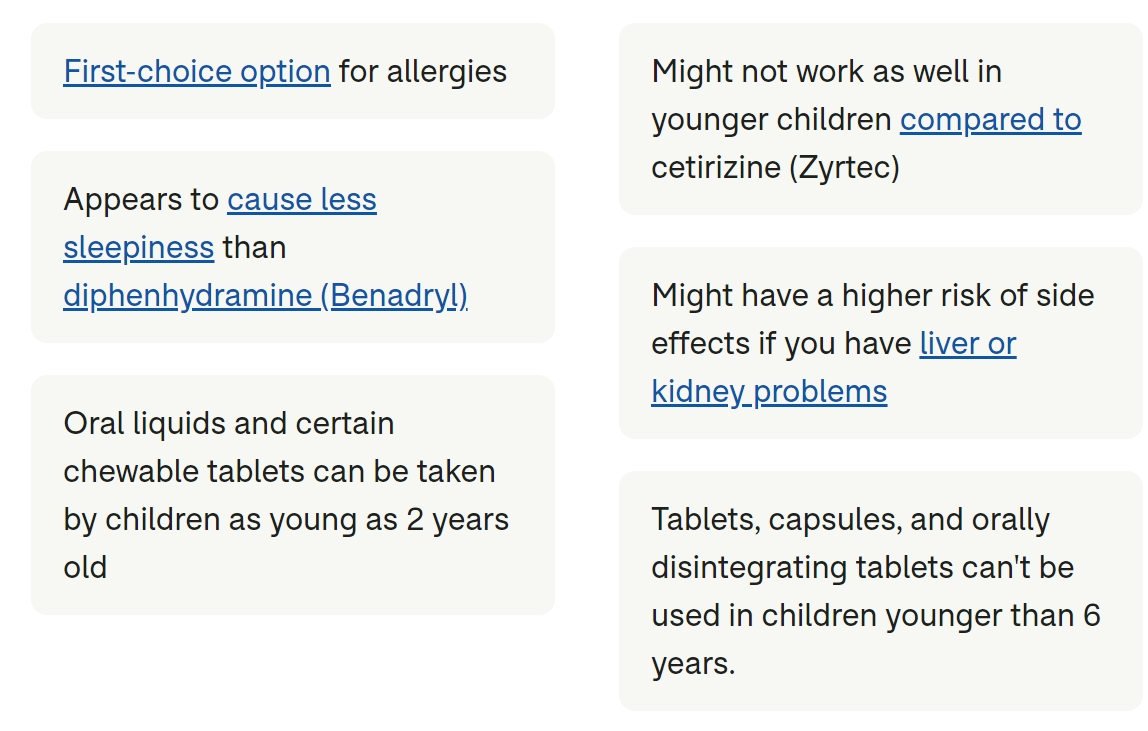Overview
Loratadine, marketed as Claritin, is an over-the-counter antihistamine used to alleviate allergy symptoms like a runny nose and watery eyes in both adults and children. Typically administered orally once a day, Loratadine is available in various forms, including tablets and liquid solutions. Known as a non-sedative medication, it is less likely to induce sleepiness compared to other antihistamines like diphenhydramine, commonly known as Benadryl. However, some may experience side effects such as headaches and fatigue.
What is Loratadine (Claritin) used for?
- Short-term relief of allergy symptoms (runny nose, itchy nose, itchy or watery eyes)
How Loratadine (Claritin) works
Loratadine (Claritin) is an antihistamine. It blocks histamine, a natural chemical in your body that can cause allergy symptoms like itchy eyes, runny nose, and sneezing. In doing so, loratadine (Claritin) helps relieve allergy symptoms.
When does Loratadine (Claritin) start working?
Time passed since treatment started:

- Loratadine (Claritin) can be taken only when you have allergy symptoms every once in a while. But if you have allergy symptoms on a daily basis, it's best to take the medication every day according to the manufacturer's directions to get the most relief.
- If you have kidney or liver problems, don't use loratadine (Claritin) without talking to your healthcare team first to make sure it's safe for you to take. This is because you might have a higher risk of side effects from the medication.
- Take loratadine (Claritin) with or without food. If it hurts your stomach, try taking it with food to help.
- Loratadine (Claritin) might make you feel a little sleepy. Don't drive until you know how this medication affects you.
- Avoid drinking alcohol while taking loratadine (Claritin) because this combination raises your risk of sleepiness and dizziness.
- Don't start any new medications while taking loratadine (Claritin), especially other antihistamines, without talking to your HCP or pharmacist first. Doing so can raise your risk of taking too much medication (overdose) and lead to severe side effects, including seizures, hallucinations (seeing things that aren't real), and even death.
- For the liquid form: Use a medication dose cup or an oral syringe to measure your dose of loratadine (Claritin). Ask your pharmacy to provide you with one if the product doesn't include it in its packaging or if you need extras. Don't use household spoons because they might not be accurate and might cause you to take the wrong dose.
- For the orally disintegrating tablet: Place the tablet on your tongue, and let it dissolve in your mouth. You can take it with or without water.
- For the chewable tablet: Chew or crush the tablets before swallowing; don't swallow the tablets whole. You don't need to eat or drink anything when you take the medication.
What are the risks and warnings for Loratadine (Claritin)?
Loratadine (Claritin) can cause some serious health issues. This risk may be even higher for certain groups. If this worries you, talk to your doctor or pharmacist about other options.
Sleepiness
- Risk factors: Drinking alcohol while taking loratadine (Claritin) | Taking other medications that cause sleepiness
Loratadine (Claritin) might make you sleepy, which can affect your ability to focus, think, or react. This side effect is more likely to happen if you drink alcohol while taking this medication or other medications that also cause sleepiness (e.g., opioids, certain anxiety medications, sleep medications). Don't drive or operate machinery until you know how this medication affects you.
Accidentally taking too much medication
Loratadine (Claritin) and other antihistamines can be found in many over-the-counter products. Taking too much loratadine (Claritin) or using more than one medication containing an antihistamine (including products used on the skin) can lead to an accidental overdose and cause serious side effects, such as seizures, hallucinations, or even death.
To prevent an accidental overdose, read package labels carefully. If you're not sure if a product has an antihistamine, ask your pharmacist. Don't start any new medications while taking loratadine (Claritin) without talking to your HCP or pharmacist first.
Caution use in people with phenylketonuria (PKU)
Some chewable tablets and orally disintegrating tablets contain phenylalanine, a component of the artificial sweetener aspartame. If you have a genetic condition called phenylketonuria (PKU), taking these forms of loratadine (Claritin) can be dangerous for you. Read the manufacturer's label on the loratadine (Claritin) product you have to see if there's a warning for people with PKU. Ask your pharmacist if you're not sure a particular loratadine (Claritin) is safe for you. There are other formulations of the medication that might be safer for you.
Strengths
Tablet
- 10mg
Dosages
The dose and direction of loratadine (Claritin) can differ depending on the manufacturer and formulation of the medication you have. This medication comes in pills and oral liquids, chewable tablets, and orally disintegrating tablets.
Be sure to follow the medication box for specific instructions. In general:
- Ages 6 years and older: The typical dose is 10 mg by mouth once per day. The maximum dose is 10 mg per day.
- Ages 2 to under 6 years: The typical dose is 5 mg by mouth once per day. The maximum dose is 5 mg per day.
- Ages under 2 years: Ask your child's pediatrician.
Read Related Articles
Interactions
Loratadine, an antihistamine used to treat allergy symptoms, can interact with several medications. Here are some of them:
Side-effects
The following side effects may get better over time as your body gets used to the medication. Let your healthcare provider know immediately if you continue to experience these symptoms or if they worsen over time.
Common Side Effects
- Headache (12%)
- Sleepiness (8%)
- Fatigue (4%)
- Dry mouth (3%)
Other Side Effects
- Dizziness
- Cough
- Sore throat
Serious Side Effects
Contact your healthcare provider immediately if you experience any of the following.
- Accidentally taking too much medication: fast heartbeat, flushing, extreme sleepiness, changes in vision, irritability in children
When do Loratadine (Claritin) possible side effects begin and end?
Time passed since treatment started:
The following side effects have also been reported
Side effects that you should report to your care team as soon as possible:
- Allergic reactions—skin rash, itching, hives, swelling of the face, lips, tongue, or throat
Side effects that usually do not require medical attention (report to your care team if they continue or are bothersome):
Common Concerns
Feedback from Our Clients
Explore feedbacks from our clients below. They reflect the dedication and expertise we bring to every interaction, and how our services have positively impacted their health.



